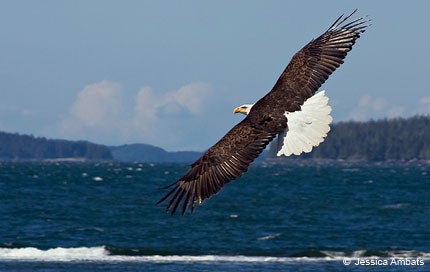 |
I was delivering a Malibu to Neuquen, Argentina, a few years ago, flying the route we usually take to Patagonia in South America. The navigation is pretty simple—keep the ocean on the right until you run out of land.
On the long leg from Guayaquil, Ecuador, to Arica, Chile, I was cruising along the Peruvian coast at a comfortable 19,000 feet, luxuriating in glycerin-smooth air, marveling at the remarkably cloud-free visibility above the spectacular Andes. To my right was nothing but blue Pacific, to my left was a quickly rising plain to knife-like mountains stacked 20,000 feet closer to the sky. In South America, the foothills start at sea level rather than 15,000 feet, as in the Himalayas.
As I looked down at the plains near the coast, I spotted the outline of a giant hummingbird on the ground. It was one of several figures on the plains of Nazca. I could clearly make out the distinct bird shape, a creation of the Nazca people of the sixth century AD. (And, no, I doubt that aliens made them do it.)
The hummingbird apparently was a god to the Nazcas, and that’s not a surprise. I, for one, understand their reverence. Birds, in general, and the humÂÂmingÂbird, in particular, deserve every pilot’s respect. Even 110 years into the age of powered flight, birds remain far more talented at flying than mere humans with their artificial, manmade aircraft.
Long before I earned a license to learn to fly, I was fascinated with bird flight. As a kid in Alaska, I used to watch the migration of waterfowl every year. I marveled at every aspect of birds’ natural flying ability: how easily and precisely they maintained formation; how effortlessly birds could leap into the air from land or water, often with no takeoff run at all; how they could maneuver so accurately, performing aerobatics instantly and changing direction in what seemed to be 90-degree turns. I knew just enough about flying to appreciate that no single aircraft had all those talents. Even helicopters couldn’t perform the same tricks.
Hummingbirds have always been the most fascinating to me. I don’t go out stalking them with binoculars and long telephoto lenses, but I’ve had feeders in my backyard practically everywhere I’ve lived for the last 40 years. On occasion, the little guys have humored me with displays of agility that even Patty Wagstaff in her Extra 330 couldn’t match.
Their wings can beat as fast as 5,000 times a minute, allowing them to maneuver unlike any other bird. There was an internet video going around a while back that showed two of the little devils fighting over food, performing loops, rolls and even flying inverted and backwards (although not at the same time); then, stopping in mid-air and darting away in the opposite direction with almost instant acceleration. I’ve often wondered what G-loads they must endure.
I’ve watched seagulls do similar maneuvers along Florida’s Gulf Coast, fighting over bread crumbs thrown into the air. Some of their aerial battles are reminiscent of unlimited aerobatic competitions. I know I spotted a vertical roll, several loops, a humpty bump or two, and I thought I saw one seagull perform a full Lomcevak in pursuit of the food I tossed in the air. Birds have an inherent ability to maneuver that puts even an Edge 540 to shame.
They also seem to sense the forces of the sky with uncanny accuracy. I’ve thermaled with Condors in the Andes, struggling to top a ridgeline and monitoring the Condors’ seemingly effortless flight for guidance. The huge birds often know intuitively where the thermals reside. They’ll soar casually into a thermal and work their way several thousand feet higher, often without any apparent effort, sometimes not moving a feather in the process.
Once, many years ago on a delivery flight in a Cessna 207 to Buenos Aires, Argentina, I followed a Condor around a thermal and rode the free lift to 13,000 feet, while he watched my comparatively ugly machine struggling to match his moves. Without his (her?) guidance, the overloaded Cessna never would have made it across the ridge from Chile to Argentina.
Climbers spot Condors regularly at elevations of 20,000 feet in South America, and a Lan Chile airline crew once reported seeing one of the giant, 10-foot wingspan birds soaring by at 32,000 feet above Cerro Aconcagua, the highest mountain in South America. Standard temperature at 32,000 feet is -44 degrees C.
As one who has a little experience flying long distances, I was especially interested in the bird investigations of Robert Gill, a wildlife biologist for the U.S. Geological Survey Science Center, who was working with migratory birds. In the 1980s, Gill noticed that a small Alaskan wading bird, the bar-tailed godwit, nearly doubled its body weight in preparation for the fall migration to New Zealand. Gill said the birds became so fat, he wondered how they could fly at all.
At the time, Gill was frustrated with his inability to track the godwits, but he believed they had to land many times on Pacific atolls during their migration south. By 2006, technology finally caught up with Gill, offering him a solution in the form of an incredibly light, one-ounce GPS tracking device. Gill transplanted the trackers into several godwits in Alaska, then monitored the GPS readout.
The birds waited for favorable winds that blow south above the Gulf of Alaska every fall. Gill monitored his test subjects electronically, as the birds waited for just the right moment, then lifted off and flew straight south down the center of the Pacific.
Many of them tracked directly to New Zealand, 7,100 miles nonstop in nine days. They made no stops on islands or ocean for anything—food, water, rest or sleep. The godwits slept bird-style by shutting down half their brain at a time while they continued to flap toward New Zealand at a steady 35 mph. Gill contacted wildlife officials in New Zealand who told him many of the birds landed after their epic flights and immediately collapsed from exhaustion, having worked off all the weight they’d put on in Alaska.
Perhaps equally amazing, some of the godwits return to the same locations every year, often touching down within a half-mile of the previous year’s destination.
No one has any idea how migratory birds navigate, although some speculate it may be a function of somehow analyzing the Earth’s magnetic field. Others theorize it may be a form of avian celestial navigation. That’s unlikely since birds on their first trip south would never have seen stars in the southern hemisphere. Perhaps they simply follow their leaders.
And perhaps birds, born to the sky, are created with something mere humans will never understand—a natural sense of flight. They need not study or analyze the ability to do what they do. They’re born understanding. In the words of Richard Bach, writer, dreamer, poet, philosopher, pilot and perhaps part bird himself, from his novel/instruction manual on pure flight, Jonathan Livingston Seagull, “Don’t believe what your eyes are telling you. All they show is limitations. Look with your understanding. Find out what you already know, and you’ll see the way to fly.”



